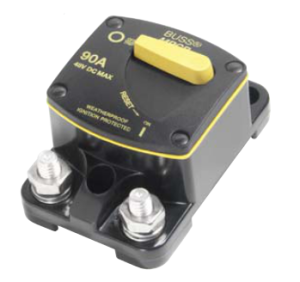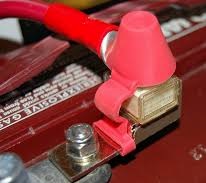Properly sized breakers can prevent fires in the case of overloads or short circuits and provide a handy way to disconnect power while you’re servicing the system
Make sure your breakers and fuses are rated for the appropriate dc voltage and breaking amperage

Dc jumps bigger gaps than ac
The dc Voltage rating assures the breaker or fuse will actually stop the current when it trips. Ac breakers may allow the current to continue to flow after they trip since dc will jump a much larger gap than the same ac voltage. See this graphic demonstration on YouTube.
Breaking amperage – if the current exceeds this rating the breaker/fuse may also fail to interrupt the current. This is very important when using large battery banks and fat cables. Most automotive fuses are rated to 1000 A breaking current, but a small sized 12-V battery bank with appropriately fat cables can easily exceed 2000 A of current if the cables get shorted together. The fuse would blow, but current jumps the gap and keeps flowing, melting down the wiring insulation and copper, possibly burning someone or starting a building fire.
Surface mount Breakers
Blue Sea/Cooper Bussmann  make appropriate surface mount breakers for 12-V and 24-V small to medium sized solar power systems. The CB187F Series can be easily screwed to a piece of plywood and has 5/16 in studs for connecting your power cables. They are marine rated and breaking amperage is 5000 A. The CB185 Series is similar but has smaller 1/4 in studs and is not marine rated.
make appropriate surface mount breakers for 12-V and 24-V small to medium sized solar power systems. The CB187F Series can be easily screwed to a piece of plywood and has 5/16 in studs for connecting your power cables. They are marine rated and breaking amperage is 5000 A. The CB185 Series is similar but has smaller 1/4 in studs and is not marine rated.
Box mounted Breakers
We recommend MidNite Solar breakers, which come in two different styles for fitting in different types of electrical boxes. They have a breaking amperage of 10,000 A and dc voltage rating up to 150 V.
MNEPV breakers  mount in a standardized DIN rail box, and are available up to 63 A
mount in a standardized DIN rail box, and are available up to 63 A
MNEDC breakers mount to the front panel of an appropriate box and can handle slightly larger wires and are rated up to 100 A.
Battery Mounted Fuses
Since there is so much power available from your battery bank it’s a really good idea to have a properly rated fuse right on each battery string in case the fat battery cables accidentally get shorted together. A MRBF terminal fuse block mounts directly on a battery stud and can break 10,000 A. Fuses come in a variety of amperages.
there is so much power available from your battery bank it’s a really good idea to have a properly rated fuse right on each battery string in case the fat battery cables accidentally get shorted together. A MRBF terminal fuse block mounts directly on a battery stud and can break 10,000 A. Fuses come in a variety of amperages.

 GTIS Power and Communications Systems
GTIS Power and Communications Systems